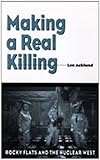Found in 2 comments on Hacker News
arethuza · 2012-08-20
· Original
thread
I'm not sure I'd call plutonium metal "not that dangerous" - it is pretty toxic, can catch fire spontaneously and once if does catch fire you have to be really careful trying to put the fire out. There is an excellent book on the history of the Rocky Flats nuclear weapons plant near Denver that describes some of the problems with handling plutonium on an industrial scale:
http://www.amazon.com/Making-Real-Killing-Rocky-Nuclear/dp/0...
Edit: Of course these things are relative. I guess compared to chemicals like chlorine trifluoride or FOOF it is pretty tame from a chemical perspective:
http://pipeline.corante.com/archives/2008/02/26/sand_wont_sa...


Even the simplest nuclear weapons design is slightly more involved than that - the gun-based design used in the "Little Boy" bomb that destroyed Hiroshima used an actual section of gun barrel to fire one chunk of uranium at the other.
More modern designs of fission bombs, either as stand-alone weapons or as primaries for H-bombs, are actually pretty complex - balancing the need to be efficient (plutonium and U235 are rather expensive), light, robust and safe is a non-trivial problem.
The W88 warhead with its prolate (egg-shaped) primary is the most advanced nuclear weapon that has had design details leaked to the public:
http://en.wikipedia.org/wiki/W88
In the case of the Sum of All Fears the terrorists were trying to build a strategic level bomb (i.e. hundreds of kt) using a fusion boosted fission design to try and start a global war - so they were actually trying to build something relatively advanced, not just a basic bomb.
Edit: Another real problem with working with plutonium is that it is fairly nasty stuff to deal with - I can recommend the book "Making a Real Killing: Rocky Flats and the Nuclear West" to get some idea of the horrors of working with plutonium on an industrial scale:
http://www.amazon.com/Making-Real-Killing-Rocky-Nuclear/dp/0...